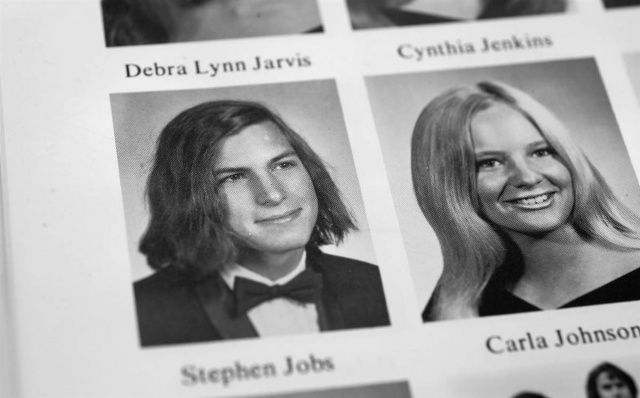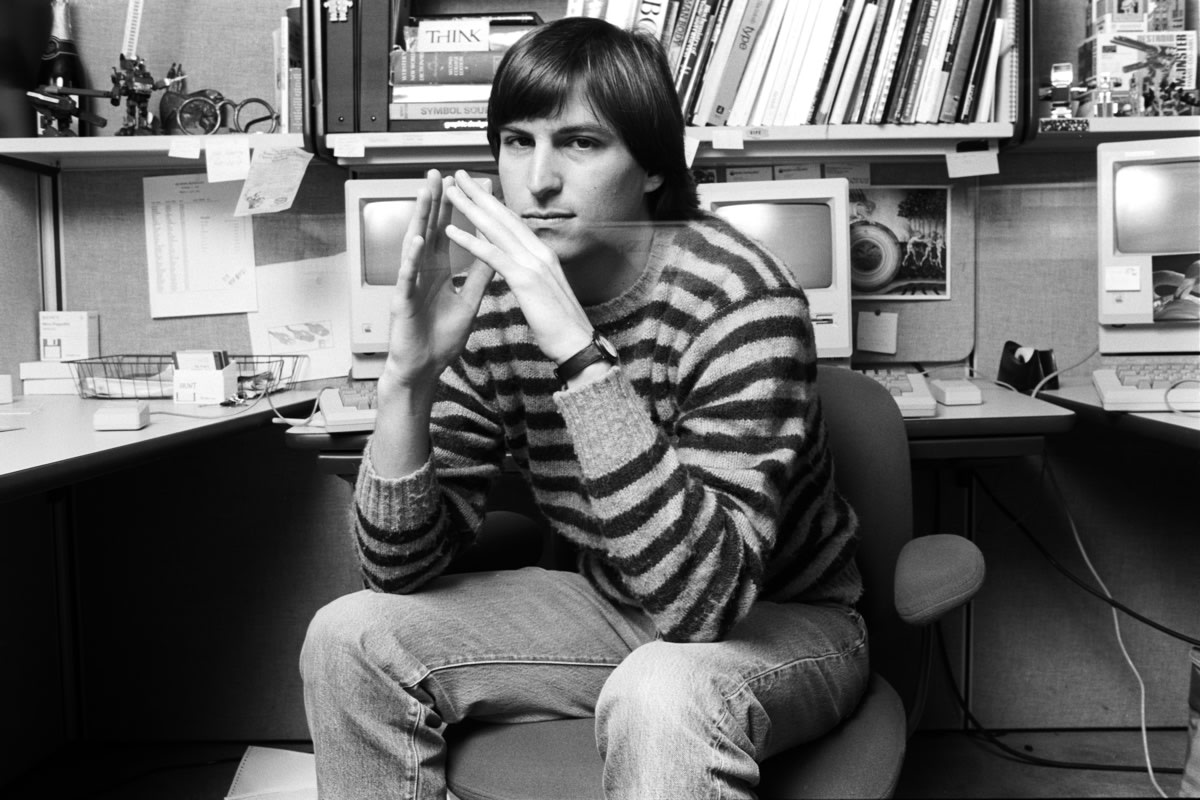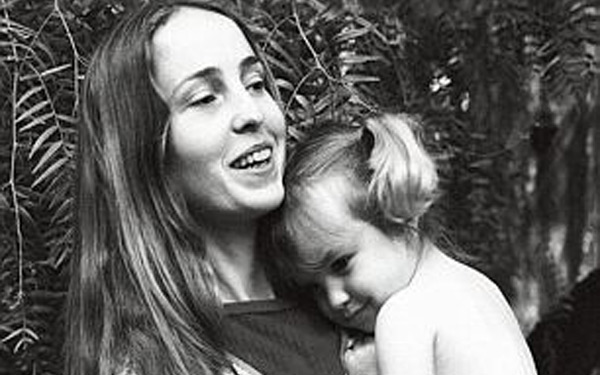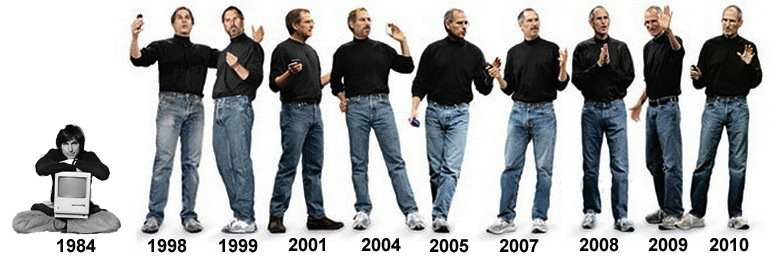In high school, a student interested in taking apart and rebuilding machines approached the CEO of Hewlett-Packard and asked for some parts to help him complete a class project. Duly impressed, the CEO made arrangements for the student to get the parts. And years later, he was probably thrilled to be able to say he took the time to do so. The confident, driven student who asked for the parts was Steve Jobs, a man who would go on to become the CEO of Apple Computers and a pre-eminent figure in the tech industry…
Early Life
Steve Jobs was born to two unmarried graduate students in 1955 (curiously, just 9 months before Microsoft founder Bill Gates). His parents gave him up for adoption, and Jobs was 30 years old and well in the midst of tech stardom before he learned about his birth parents, the Simpsons. Growing up, the only family he knew was his adoptive parents, a couple from Mountain View, California who fostered his interest in taking apart and rebuilding machines. His father, Paul Jobs, was a machinist who taught Jobs about electronics from an early age. Working in the family garage, the two spent hours tinkering on projects.

During these work sessions in the garage, Jobs’ father taught him a lesson that has made its way into Apple products of all shapes and sizes.
Jobs later described this, saying, “When you’re a carpenter making a beautiful chest of drawers, you’re not going to use a piece of plywood on the back, even though it faces the wall and nobody will ever see it. You’ll know it’s there, so you’re going to use a beautiful piece of wood on the back. For you to sleep well at night, the aesthetic, the quality, has to be carried all the way through.”
Though Jobs showed an early interest in mechanics and design, he did not show early promise in school. His mother had taught him to read as a toddler, but he was bored in school and often goofed off, a habit that frustrated one teacher to the point of bribing him to behave. This teacher saw potential in a young Jobs, and Jobs later credited Mrs. Hill with being one of the “saints” of his life.

Jobs so excelled in that fourth grade class with Mrs. Hill that he skipped over the fifth grade entirely and headed straight for middle school. This jump ahead was tough for him initially: he was bullied and became a bit of a loner. Indeed, he disliked middle school so much that he told his parents that if he couldn’t switch schools he would just stop going to school altogether. To keep Jobs in school, the family moved from Mountain View to Los Altos, and Jobs settled into the Cupertino School District.
It was here, that he met and befriended Bill Fernandez, another student interested in electronics. Fernandez later played a critical role in the creation of Apple computers when he introduced Jobs to his neighbor – another electronics aficionado, and someone you might have heard of… His neighbor was Steve Wozniak (more on him in a minute).

Early Work
By the time he entered high school, Jobs was already working at Hewlett-Packard, where a cold call to the CEO had earned him a job offer. But while he was in high school his interests began to diversify quite a bit. Jobs discovered a love for the classics and for literature in general – Dylan Thomas and Shakespeare were particular favorites. During his senior year, Jobs was so excelling in English that he was able to take classes at Stanford.
When it came time to attend college, though, Jobs opted to attend Reed State in Oregon. But, well, that didn’t last long. After only one semester, Jobs’ previous aversion to formal education reared its head and he dropped out. He continued dropping in on classes that interested him, though he wasn’t earning credits and wasn’t paying for anything. Interestingly, one of those drop-in classes greatly affected his future. Something that he explained in his famous 2005 Stanford commencement address (something, by the way, that is well worth watching).
“If I had never dropped in on that single calligraphy course in college, the Mac would have never had multiple typefaces or proportionally spaced fonts.”
Career Beginning
Despite being a college dropout, Jobs was able to secure a job with Atari computers in 1974. He worked as a tech, assisting the engineers who were doing the heavy duty coding work. Jobs didn’t have a lot of money at this time, and he was trying to scrape funds together to travel to India to study Eastern religion – his interests in things outside technology had stuck around. The head of Atari, Neil Bushnell, years later said he thought Jobs was saving money by actually living in the office…
“I’m not sure about this but I actually think Steve was living there, so people used to complain that he didn’t smell that well… I’d come in on the weekend and he’d be there, I’d come in late at night and he’d be there.”
The time at Atari also marked a key point in the friendship between Jobs and his old friend Steve Wozniak. Jobs was assigned to design a circuit board for the video game Breakout, and he approached Wozniak to help because Atari was offering a bonus if it could be designed using fewer chips. Jobs also needed the project completed in only four days. What Jobs didn’t tell Wozniak was that Atari had offered Jobs a large bonus for using fewer chips – a bonus Jobs received and kept for himself even though Wozniak did the majority of the work. When Wozniak found out about the lie ten years later, he is reported to have cried.

But Wozniak didn’t know of Jobs’ deceit at the time, and the two continued experimenting with technology together. But, their tinkering was put on hold for seven months, though, when Job’s alleged living in the office had saved him enough money to travel to India. He went to India in search of spiritual enlightenment, something that was rather in fashion in the 60s and 70s. He did this trip on an incredibly tight budget – he slept on the street, sweated on crowded buses, and ate the bare minimum… He also must have eaten some pretty sketchy food, reportedly getting dysentery and losing forty pounds.
During this time he was also meditating and learning about Zen Buddhism. He wanted to go to Tibet, but after his travelers’ checks were stolen he decided to head home to the U.S. Back home, he continued his practice of meditation, as well as another habit he’d picked up… his use of psychedelic drugs. Jobs was a big fan of LSD, a drug he started using in college and would credit with expanding his creativity and vision of the world:
“Taking LSD was a profound experience, one of the most important things in my life. LSD shows you that there’s another side to the coin, and you can’t remember it when it wears off, but you know it. It reinforced my sense of what was important—creating great things instead of making money, putting things back into the stream of history and of human consciousness as much as I could.”
The Beginning of Apple
Back in the United States, Jobs had no money and lived in his parents’ toolshed that he had converted to a bedroom. But he and Wozniak continued to work on computers, with Jobs convincing Wozniak that at least one of Wozniak’s early products was sellable. Wozniak had built a product, known as a ‘blue box’ that could mimic the tones of a telephone system and essentially trick a phone into making a free long distance call for the user.

With technology today we don’t think twice about calling someone on the other side of the planet, but In the 1970s this was a big deal. Now, as you might have guessed, these blue boxes were totally illegal, but they still sold well. Yep, Steve Job’s first business… Selling illegal devices to make long distance phone calls for free!
Now, the next brainchild that Wozniak had was much more legitimate… It was a product that would become the Apple I. In 1976, Jobs suggested selling it, and he and Wozniak officially started Apple Computers. The company was first run out Jobs’ parents’ garage, and most of their customers were hobbyists. But enough computer hobbyists were laying out money for the Apple I that Jobs and Wozniak had cash in their pockets. Jobs began searching for investors, and Wozniak kept designing.

In 1977, just a year after the company launched, they put out another version of their computer, the Apple II. This time, it had color graphics and was much more user-friendly allowing for it to be used outside of just the hobbiest market. They sold $3 million of the Apple II in their first year alone, but this figure was about to become dwarfed… Two years later, they had sold $200 million-worth, but again, this seemingly huge number was about to be dwarfed again…
In 1980, only four years after their launch, Jobs and Wozniak went public. By the end of Apple’s first day of public trading the company was worth an astounding $1.2 BILLION. Steve Jobs was only twenty-five years old.
Family
During the nascent years of Apple, Jobs was dealing with much personal turmoil. His longtime on-again, off-again girlfriend Chrisann Brennan had moved in with him, and she got pregnant. Jobs was, by all accounts, not thrilled about this news. He later told Brennan: “I never wanted to ask that you get an abortion. I just didn’t want to do that.”
Brennan had been offered a job at Apple, but given Jobs’ reaction to her pregnancy she did not want to take it. She left him and their house, and began working as a cleaner.

Despite asking for support from Jobs, he did not provide any support for his child until a paternity confirmed that he was the father. Even then, despite his company being worth over a billion dollars, he was only required to provide $500 a month in child support.
Despite these early problems, Lisa and Jobs later reconciled, and Lisa even lived with Jobs during her high school years. She then attended Harvard, and today works as a writer in New York City.
Though it took him years to admit to it, Jobs named one of Apple’s early products after his daughter. But the LISA computer was not as successful as the Apple II had been. This failure was followed by another – the Apple III, which again failed to live up to expectations (and not just Job’s expectations, but everyones).
Getting Sent to “Siberia”
Despite Apple being Job’s company, the fact that is was public, meant that the Apple board had the power to oust him as CEO. And in 1983, they did just that. They didn’t fire him though, they just sent him to “Siberia” (not literally of course, but he referred to the office he was put in as Siberia, illustrating well the fact that he was in some sort of exile.)
Most Apple employees were probably pleased to see him go…. He was notoriously difficult to deal with, and a former Apple employee described Jobs’ attitude toward work as “management by character assassination.” By 1985, he was tired of hanging out in Siberia and decided to leave the company he had founded and start a brand new one.

“What had been the focus of my entire adult life was gone, and it was devastating,” Jobs said of this experience. “I even thought about running away from the valley. But something slowly began to dawn on me-I still loved what I did. And so I decided to start over.”
He started “Next Computer Company,” which brought its first product to market in 1988. That computer, though, it had a price of $10,000, a price way higher than most consumer were willing to pay.
Needless to say, it didn’t sell well.
It wasn’t a good start for Job’s fledgling company and so he decided to shift the company to building software.
Pixar
But Jobs’ focus was drawn elsewhere… somewhere rather unusual – the movies. In 1986, he bought Pixar from George Lucas. As part of his dream for this company, Jobs wanted to be responsible for the first movie done entirely with computer-animation. It took four years, but he eventually achieved that dream.

That movie was Toy Story. It was released in November 1995 it became a favorite film for kids and adults, and to this day maintains a perfect 100% score on Rotten Tomatoes.. A year after the release of Toy Story, there was even better news… Jobs took Pixar public and in something of a deja vu situation, his shares were worth one BILLION dollars after the first day of trading.
This first day of trading was the first in a string of good days for Jobs. Shortly after Pixar went public, Apple put out the welcome mat for Steve Jobs to return. When he returned in 1997 the company was operating at a loss, and they needed Jobs’ vision and drive back at the helm. Apple also announced that they would buy the struggling Next Computer Company – turning a previous failure of Jobs into a success…
Return to Apple
Jobs triumphantly returned to the company that he founded. The company wanted him to bring Apple to the forefront of the personal computer market. Within months of his return, Jobs was named CEO. He paid himself a salary of only one dollar a year, and in exchange brought both business acumen and creative design ideas to the company He negotiated a financial deal with Microsoft that brought Apple cash flow it needed to stay afloat, while helping Microsoft avoid the perception that they were a monopoly.
Then, he envisioned the big idea that helped bring Apple back to profitability in its own right – the iMac.
It was in 1998 that Apple released the brightly colored, egg-shaped desktop computer called the iMac. The iMac is even still made today… although it looks rather different today!

From the iMac forward, Apple and Jobs just couldn’t miss. They revolutionized the way people listen to music in 2001 with the iPod, and then the way they communicated in 2007 with the iPhone, and then were pioneers in the tablet market with the 2010 release of the iPad.
Jobs once said of Apple, “We started out to get a computer in the hands of everyday people, and we succeeded beyond our wildest dreams.”
Today, it’s nearly impossible to walk down the street without seeing someone with an Apple-made device in their hands.
Through these years of professional success, Jobs had still found the time to focus on his family. In 1986 his adoptive mother was diagnosed with lung cancer, and this, for the first time, prompted Jobs’ interest in his biological parents.
When his adoptive mother passed away, Jobs spoke to his father about contacting his birth parents, whose names he had on documents from his parents. Jobs met both his birth mother, Joanna Scheible, and his biological sister, Mona Simpson, shortly after his adoptive mother died. Scheible and Jobs’ birth father had divorced in 1962 when the Syrian migrant opted to return to Syria after earning his PhD.
When Jobs was introduced to Mona, she was still searching for their father. Jobs joined her in the search, and what they found out was surprising. Their father was not in Syria working in academia… Rather, their father was living in California and running a restaurant. Incredibly, Jobs said he had met the man Mona identified as their father, he had shaken his hand, had eaten in his restaurant… but never knew he was his father. Jobs had no interest in getting to know his father as he had gotten to know his mother and Mona, though, explaining his decision by saying, “I learned a little bit about him and I didn’t like what I learned.”

While getting to know his birth family, Jobs also decided to start a family of his own. In 1989, Jobs gave a lecture at Stanford Business School and he was riveted by a woman in the front row.
“She was right there in the front row in the lecture hall, and I couldn’t take my eyes off of her … kept losing my train of thought, and started feeling a little giddy,” this is how he described feeling when he first saw Laurene Powell.

Laurene Powell was an MBA student at Stanford, and Jobs struck up a conversation with her after the lecture. He invited her out to dinner that night, and the two began a romantic relationship. A Zen Buddhist monk presided over their wedding ceremony at Yosemite National Park in 1991, and over the next seven years the couple had three children. They remained married until Jobs’ death in 2011.
Sickness
Amidst all of the successes of the early years of the 21st Century, Jobs was not free from worry. And neither was Apple Computers. In 2003, Jobs received the news all of us dread – he had cancer. His doctors had found a cancerous tumor in his pancreas, and though operable it was a rare form of cancer… Jobs refused to listen to his doctors and have an operation right away, though. Instead he opted to explore other options, namely veganism and acupuncture. In 2004, with these alternative methods not improving his condition, Jobs opted to have the tumor surgically removed. Several cancer specialists have since said that period of waiting may have cost Jobs years of his life.

In 2005, Jobs gave a commencement address at Stanford University that frankly and poignantly discussed his thoughts on life and death now that he had to confront the matter head-on. The fifteen minute speech reflected on three moments in his life that helped get him to where he was, and in telling those stories he imparted a message to the graduates – and to the world – to do what you love, remember you are going to die, and have trust in your inner voice.

“Remembering that I’ll be dead soon is the most important tool I’ve ever encountered to help me make the big choices in life. Because almost everything-all external expectations, all pride, all fear of embarrassment or failure-these things just fall away in the face of death, leaving only what is truly important. Remembering that you are going to die is the best way I know to avoid the trap of thinking you have something to lose. You are already naked. There is no reason not to follow your heart,” he said.
“Remembering that I’ll be dead soon is the most important tool I’ve ever encountered to help me make the big choices in life.” Steve Jobs
He closed the speech with simple words from the 1970s counter-cultural magazine The Whole Earth Catalog: “Stay hungry. Stay Foolish.”
The commencement address struck a chord around the world. It has been viewed over 27 million times on YouTube and serves as an inspiration, and a stark reminder of our limited time on Earth. It is a speech that truly every human can relate to, given by a man whose mind and drive were far more extraordinary than most humans…
Death
Jobs continued to work at Apple following the surgery, but in 2008 people began asking questions about his health as his appearance began to show his illness. He was gaunt, graying, and just didn’t seem healthy. The company continued to explain this away… After questions were raised at one tech event Apple attributed his appearance to a simple bug and said he was taking antibiotics. Shareholders continued to worry, and in 2009 the truth came out – Jobs was suffering from ill health and ended up having a liver transplant. Tim Cook, Apple’s head of Worldwide Sales, filled in as CEO while Jobs was recovering from the procedure.

Jobs managed to return to his post and continued to be involved in the day-to-day operations of Apple with his prognosis being described as “excellent”.
But it was not to be. Only a year and a half after returning to the helm of Apple Jobs had to step down as CEO. In providing his reasons to the company’s board, he stated:
“I have always said if there ever came a day when I could no longer meet my duties and expectations as Apple’s CEO, I would be the first to let you know. Unfortunately, that day has come.”
Though he stepped down as CEO and handed Tim Cook the reins of his company, Jobs did serve as Chairman of the Apple Board. Sadly, it was for only six weeks that he would work for Apple in this capacity. On October 4, 2011, Jobs lost consciousness. He stayed at home, surrounded by his family, and died of complications from his pancreatic cancer on October 5th. He was only 56 years old.
The world greeted the death of this technology icon with shock and grief. California’s Governor issued a proclamation for a Steve Jobs Day to be celebrated, and the companies with which he was associated all issued statements about the life, creativity, and innovation of their founder and partner.
His family held a private funeral, the details of which are still unknown.

In 56 years of life and 30 years in the tech industry, Steve Jobs was at the helm of guiding the world into the future. He was certainly a difficult man to deal with, but he was an innovator, a businessman, and a visionary whose ideas shaped the world we live in today.

Steve Jobs Video Biography
Sources:
- https://www.biography.com/people/steve-jobs-9354805
- http://www.npr.org/2011/10/25/141653658/steve-jobs-a-computer-icon-on-life-death-and-apple
- https://www.inc.com/minda-zetlin/5-profound-life-lessons-from-steve-jobs-iconic-stanford-commencement-speech.html
- https://www.entrepreneur.com/article/197538
- http://www.notablebiographies.com/Ho-Jo/Jobs-Steve.html
- http://www.ibtimes.com/steve-jobs-teacher-bribed-him-learning-322278
- https://en.wikipedia.org/wiki/Steve_Jobs
- http://www.gadgetsnow.com/tech-news/Steve-Jobs-was-a-problematic-employee-Atari-founder-Nolan-Bushnell/articleshow/51193531.cms
- http://newsfeed.time.com/2011/10/24/how-steve-jobs-accidentally-met-his-biological-dad/
- https://www.forbes.com/sites/carminegallo/2015/06/12/why-steve-jobs-commencement-speech-still-inspires-10-years-later/#24fbed6648d8
- http://content.time.com/time/specials/packages/article/0,28804,1873486_1873491_1873461,00.html


